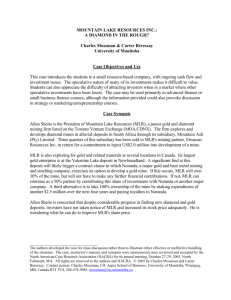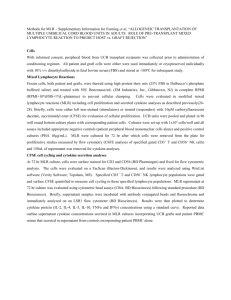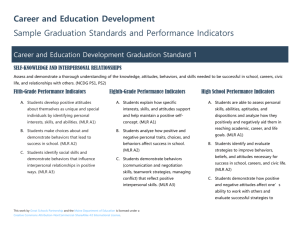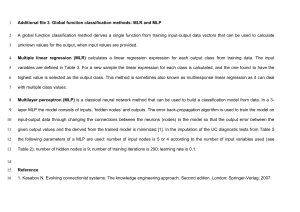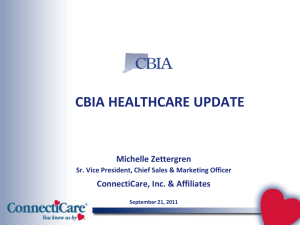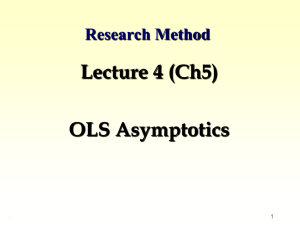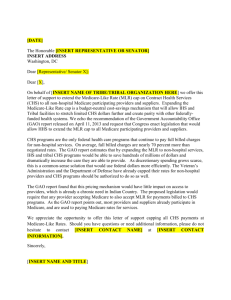Issue Brief: Minimum Medical Loss Ratio Requirements
advertisement
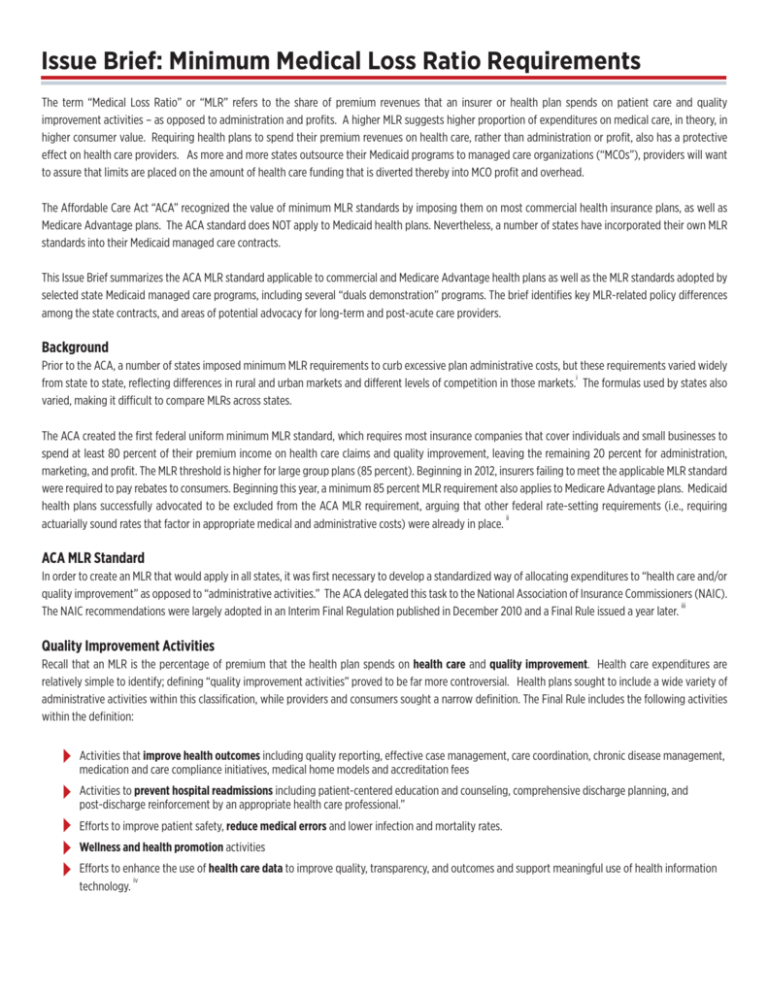
Issue Brief: Minimum Medical Loss Ratio Requirements The term “Medical Loss Ratio” or “MLR” refers to the share of premium revenues that an insurer or health plan spends on patient care and quality improvement activities – as opposed to administration and profits. A higher MLR suggests higher proportion of expenditures on medical care, in theory, in higher consumer value. Requiring health plans to spend their premium revenues on health care, rather than administration or profit, also has a protective effect on health care providers. As more and more states outsource their Medicaid programs to managed care organizations (“MCOs”), providers will want to assure that limits are placed on the amount of health care funding that is diverted thereby into MCO profit and overhead. The Affordable Care Act “ACA” recognized the value of minimum MLR standards by imposing them on most commercial health insurance plans, as well as Medicare Advantage plans. The ACA standard does NOT apply to Medicaid health plans. Nevertheless, a number of states have incorporated their own MLR standards into their Medicaid managed care contracts. This Issue Brief summarizes the ACA MLR standard applicable to commercial and Medicare Advantage health plans as well as the MLR standards adopted by selected state Medicaid managed care programs, including several “duals demonstration” programs. The brief identifies key MLR-related policy differences among the state contracts, and areas of potential advocacy for long-term and post-acute care providers. Background Prior to the ACA, a number of states imposed minimum MLR requirements to curb excessive plan administrative costs, but these requirements varied widely i from state to state, reflecting differences in rural and urban markets and different levels of competition in those markets. The formulas used by states also varied, making it difficult to compare MLRs across states. The ACA created the first federal uniform minimum MLR standard, which requires most insurance companies that cover individuals and small businesses to spend at least 80 percent of their premium income on health care claims and quality improvement, leaving the remaining 20 percent for administration, marketing, and profit. The MLR threshold is higher for large group plans (85 percent). Beginning in 2012, insurers failing to meet the applicable MLR standard were required to pay rebates to consumers. Beginning this year, a minimum 85 percent MLR requirement also applies to Medicare Advantage plans. Medicaid health plans successfully advocated to be excluded from the ACA MLR requirement, arguing that other federal rate-setting requirements (i.e., requiring ii actuarially sound rates that factor in appropriate medical and administrative costs) were already in place. ACA MLR Standard In order to create an MLR that would apply in all states, it was first necessary to develop a standardized way of allocating expenditures to “health care and/or quality improvement” as opposed to “administrative activities.” The ACA delegated this task to the National Association of Insurance Commissioners (NAIC). iii The NAIC recommendations were largely adopted in an Interim Final Regulation published in December 2010 and a Final Rule issued a year later. Quality Improvement Activities Recall that an MLR is the percentage of premium that the health plan spends on health care and quality improvement. Health care expenditures are relatively simple to identify; defining “quality improvement activities” proved to be far more controversial. Health plans sought to include a wide variety of administrative activities within this classification, while providers and consumers sought a narrow definition. The Final Rule includes the following activities within the definition: Activities that improve health outcomes including quality reporting, effective case management, care coordination, chronic disease management, medication and care compliance initiatives, medical home models and accreditation fees Activities to prevent hospital readmissions including patient-centered education and counseling, comprehensive discharge planning, and post-discharge reinforcement by an appropriate health care professional.” Efforts to improve patient safety, reduce medical errors and lower infection and mortality rates. Wellness and health promotion activities Efforts to enhance the use of health care data to improve quality, transparency, and outcomes and support meaningful use of health information iv technology. On the other hand, the following activities are explicitly excluded from the definition: Concurrent and retrospective utilization review Fraud prevention activities beyond the scope of those activities that recover incurred claims Provider network management activities Provider credentialing Marketing expenses Administration costs associated with enrollee or employee incentives Clinical data collection without any subsequent analysis Claims adjudication expenses 24-hour customer service or health care professional hotline addressing non-clinical member questions. State Medicaid Approaches to MLR v Minimum MLRs Requirements for Medicaid MCOs, October 2010 While the ACA’s MLR requirement does not apply to Medicaid, a 2011 study found that 11 states and the District of Columbia imposed minimum MLR standards ranging from 80 to 93 percent in their Medicaid managed care contracts as of October 2010. According to this study, seven of these states allowed the inclusion of direct care management as a medical expense, while the other five did not. Table 1 summarizes the minimum MLR requirements for seven current state Medicaid contracts that were reviewed for this brief. The provisions reviewed varied significantly in their level of detail and in some cases referred to a “Medical Cost” or “Medical Expense” ratio rather than an MLR. Of the contracts or Requests for Proposal reviewed, six impose a minimum MLR of at least 80 percent or higher and the majority are at 85 percent or higher. One state (Texas) imposes a plan specific “Administrative Expense Cap” that includes a fixed component and a percentage component. The Administrative Expense Cap, in turn, is used to calculate an “Experience Rebate” that ensures excess profits are refunded to the state. Thus, an overall minimum percentage could not be determined for Texas. Table 1: Selected Current Medicaid Minimum MLR Requirements State/Program Minimum MLR Care management a medical expense? Refund/or sanctions for non-compliance? Other Profit Cap? Arizona vii Long Term Care System (ALTCS) 85% Yes State may sanction No Florida viii Statewide Medicaid Managed Care Program 85% Yes CMS to determine corrective action No Illinois ix Integrated Care Program 88% No Refund required No New Jersey xi 2013 Medicaid Managed Care Contract 80% Yes State may impose liquidated damages No New Mexico xii Centennial Care 85% Yes Refund required Yes Plan specific Admin Expense Cap Unknown Refund required Yes 83% No Refund required No Texas xiii Uniform Managed Care Terms and Conditions Washington xiv Basic Health and Healthy Options x A majority of the states reviewed allow care management costs to be counted as medical expenses. Illinois also explicitly adds incentive payments to network providers, as well as litigation reserves and payments in settlement of claims disputes (excluding legal fees) as medical expenses. Notably, the minimum MLR requirement in Florida’s recently approved Medicaid managed care program is calculated in a manner consistent with the ACA MLR standard. This requirement was added as a condition of waiver approval by the Centers for Medicare and Medicaid Services (CMS), causing some insurers xv to express concern that CMS could create a federal minimum MLR requirement for Medicaid in the future. In addition to a minimum MLR requirement, two of the states reviewed impose limits on health plan profits. New Mexico allows its Medicaid health plan to retain three percent of net capitation as profit. Any profits generated above three percent are shared 50-50 with the state. Texas imposes a tiered Experience Rebate on net income (before taxes) above three percent: Table 2: Texas Experience Rebates Tiers Pre-tax Income as a % of Revenues MCO Share HHSC Share ≤ 3% 100% 0% > 3% and ≤ 5% 80% 20% > 5% and ≤ 7% 60% 40% > 7% and ≤ 9% 40% 60% > 9% and ≤ 12% 20% 80% > 12% 0% 100% MLR Requirements Dual Eligible Financial Alignment Demonstrations As of August 2014, 10 states have entered into Memoranda of Understanding (MOUs) with CMS to implement capitated Financial Alignment Demonstrations xvi xvii to cover persons dually eligible for Medicare and Medicaid. While a minimum MLR is not a demonstration requirement, MOUs for seven of the 10 states include a minimum MLR while Massachusetts will use risk corridors in the first year of the demonstration only, and California will use limited risk corridors in all years. Texas imposes a plan specific Administrative Expense Cap, similar to that of the Texas STAR+PLUS program. Table 3 below summarizes the MLR provisions for the 10 states. Ohio and Virginia are notable for their higher minimum MLR requirement (90 percent). Table 3: Selected Dual Demonstration MLR Provisions xviii State MLR Requirement California • No MLR requirement • Risk corridors established for all Demonstration years Illinois • 85% Target MLR • If < 85%, plan must remit excess amount, multiplied by total contract revenue • Methodology: Medicare Advantage requirements “to the maximum extent possible” Massachusetts • No MLR requirement • Risk corridors established for Demonstration year 1 only Michigan • 85% Target MLR • If < 85%, plan must remit excess amount, multiplied by total contract revenue • Methodology: Medicare Advantage requirements “to the maximum extent possible” Continued - Table 3: Selected Dual Demonstration MLR Provisions xviii State MLR Requirement New York • 85% Target MLR • If < 85%, plan must remit excess amount, multiplied by total contract revenue • Methodology: Medicare Advantage requirements “to the maximum extent possible” Ohio • 90% Target MLR • If 85%‐90% MLR, CMS/State may require a corrective action plan or levy a fine • If < 85%, plan must remit excess amount, multiplied by total contract revenue • Methodology: Prevailing regulatory requirements applicable to other products offered by the Demonstration health plans “to the maximum extent possible” South Carolina • 85% Target MLR • If < 85%, plan must remit excess amount, multiplied by total contract revenue • Methodology: Medicare Advantage requirements “to the maximum extent possible” Texas • Plan must pay to CMS/State an Experience Rebate based on net income before taxes (see Table 3); State/CMS will set administrative cap on the amount of administrative expenses that can be used to calculate net income before taxes • Methodology: Net income before taxes and Revenues and Allowable Expenses, will be measured through the established Texas Financial Statistical Reporting system Virginia • 90% Target MLR • If 85%‐90% MLR, CMS/State may require a corrective action plan or levy a fine • If < 85%, plan must remit excess amount, multiplied by total contract revenue • Methodology: Prevailing regulatory requirements applicable to other products offered by the Demonstration health plans “to the maximum extent possible” Washington • 85% Target MLR • If < 85%, plan must remit excess amount, multiplied by total contract revenue • If 85%‐90% MLR, plan must remit 50% of the amount by which 90% exceeds the plan’s actual MLR multiplied by the total applicable contract revenue • Methodology: Prevailing regulatory requirements applicable to other products offered by the Demonstration health plans “to the maximum extent possible” Advocacy Considerations for Long Term and Post-Acute Care Providers As states increasingly turn to managed care delivery care systems for their disabled and frail populations, long-term and post-acute care providers will be impacted by the MLR policies that states adopt. In general, the interests of states and providers are likely aligned on the issue of limiting health plan profit. States may place more value on the designation of care coordination and care management strategies as medical expenses, since these are viewed as having longer-term potential to improve health outcomes and reduce health care costs. Many states have included a minimum MLR requirement in their managed care arrangements, typically set at 85 percent or higher (as is the case in four of the six current Financial Alignment Demonstration MOUs). Since the trend towards managed care for the aged and disabled population is relatively new, it is too soon to know whether these MLR standards are being closely monitored, enforced, and/or effective in assuring the efficient expenditure of health care funding. Long term and post-acute care providers in a state that is transitioning to Medicaid managed care, planning to impose a new minimum MLR requirement, or revise an existing requirement should consider urging the state to: Impose a minimum MLR requirement of at least 85 percent with well-defined criteria for what qualifies as a medical expense Put in place adequate health plan reporting requirements and robust state oversight to ensure health plan compliance Incorporate a refund requirement into health plan contracts to allow the state to recoup excess administrative expenses and profit Consider imposing a separate limit on profits or profit sharing, especially in situations where managed care is being implemented for the first time (in an unmanaged geographic areas or an unmanaged population) as new utilization controls under managed care could otherwise result in larger than expected profits. Conclusion The ACA recognizes the value of minimum MLR standards as a health reform measure, by imposing them upon commercial health plans and Medicare Advantage plans in order to maximize that portion of premiums spent on health care rather than administration and profit. A number of states also impose minimum MLR requirements in their Medicaid managed care programs, and others are likely to consider adding this requirement—either on their own initiative or as a condition of waiver approval as was the case in Florida. In the future, the federal government may also elect to apply a uniform federal minimum MLR standard to Medicaid managed care programs. Until then, Medicaid providers and other stakeholders can monitor MLR policy development in their states, and advocate as necessary to limit the extent to which Medicaid funding is diverted to health plan administration and profit in the course of the transition to managed care. i) Tara Adams Ragon, J.D., “The Affordable Care Act and Medical Loss Ratios: Federal and State Methodologies,” Seton Hall University School of Law, Center for Health & Pharmaceutical Law and Policy, May 2012. ii) “MCOs Concerned About Federal MLR As Florida Implements CMS’ Requirements,” InsideHealthPolicy, April 1, 2013. iii) Tara Adams Ragon, May 2012. iv) 45 CFR § 158.150(b)(2). v) 45 CFR § 158.150(c). vi) Arizona, Hawaii, Illinois, Indiana, Maryland, New Jersey, New Mexico, Ohio, Virginia and Washington. See K. Gifford, V.K. Smith, D. Snipes and J. Paradise, “A Profile of Medicaid Managed Care Programs in 2010: Findings from a 50-State Survey,” Kaiser Commission on Medicaid and the Uninsured, September 2011. vii) AHCCCS MLR-Related Contract Language, CYE 2014 ALTCS EPD Contract Amendment, 10/01/2013, Section 52, Page 89 of 255, accessed at http://www.azahcccs.gov/commercial/Downloads/ContractAmendments/ALTCSCYE14Contract10113.pdf. viii) Statewide Medicaid Managed Care Program, 2012 - 2015 Health Plan Model Contract Attachment II – Core Contract Provisions, 01/01/2013, Section D-20, Page 37 of 258, accessed at http://www.fdhc.state.fl.us/MCHQ/Managed_Health_Care/MHMO/docs/contract/1215_Contract/2012-2015/Jan2013/2012-15_HP-ContractAtt-II_GEN-AMEND1-JAN-2013-CLEAN.pdf ix) 2010 Integrated Care Program RFP, Section 7.4, Pages 56-57, accessed at http://www2.illinois.gov/hfs/ManagedCare/Documents/icprfp.pdf . x) Integrated Care Program: Frequently Asked Questions, accessed at http://www2.illinois.gov/hfs/SiteCollectionDocuments/ICPFAQs.pdf. xi) 2013 MCO Contract (does not include LTSS), “07/2013 Accepted”, Article 7, Pages 34-35, and Article 8, Pages 3-4, accessed at http://www.state.nj.us/humanservices/dmahs/info/resources/care/hmo-contract.pdf . xii) New Mexico 2012 Centennial Care RFP, Section 7.2, Page 191, accessed at http://www.hsd.state.nm.us/pdf/rfps/Centennial%20Care%20RFP%20and%20Contract%20(8-28-12)(FINAL).pdf . xiii) Texas Health & Human Services Commission, Uniform Managed Care Terms & Conditions, Section 10.10, Page 36, accessed at http://www.hhsc.state.tx.us/medicaid/UniformManagedCareContract.pdf . xiv) Washington State Health Care Authority, Managed Care Contract, Basic Health and Healthy Options, Section 4.2, Page 36, accessed at http://www.hca.wa.gov/Documents/managed_care/2012BH-HOFinalContract.pdf. xv) InsideHealthPolicy, April 1, 2013. xvi) MaryBeth Musumeci, “Financial and Administrative Alignment Demonstrations for Dual Eligible Beneficiaries Compared: States with Memoranada of Understanding Approved by CMS,” Kaiser Commission on Medicaid and the Uninsured, Issue Brief, September 2013. xvii) “Guidance for Organizations Interested in Offering Capitated Financial Alignment Demonstration Plans,” Center for Medicaid and Medicare-Medicaid Coordination Office, January 25, 2012, accessed at http://www.cms.gov/Medicare-Medicaid-Coordination/Medicare-and-Medicaid-Coordination/Medicare-Medicaid-Coordination-Office/Downloads/FINALCMSCapitatedFinancialAlignmentModelplanguidance.pdf. xviii) Financial Alignment Demonstration Memoranda of Understanding accessed at: http://www.cms.gov/Medicare-Medicaid-Coordination/Medicare-and-Medicaid-Coordination/Medicare-Medicaid-Coordination-Office/FinancialModelstoSupportStatesEffortsinCareCoordination.html. For more information, contact Kim Zimmerman at kzimmerman@ahca.org or Mike Cheek at mcheek@ahca.org.
